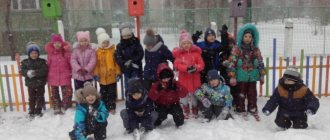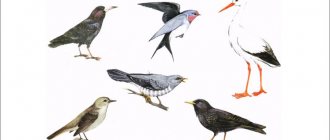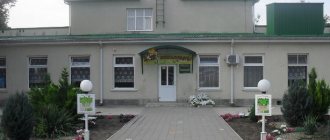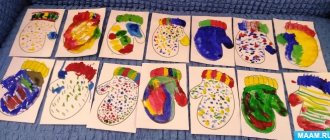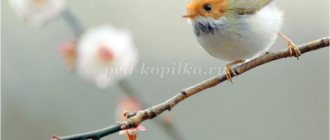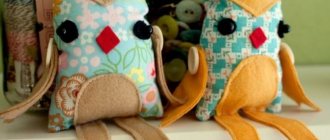ECOLOGICAL PROJECT “WINTERING BIRDS” (second junior group)
Transcript
1 ECOLOGICAL PROJECT “WINTERING BIRDS” (second junior group)
2 PROJECT PASSPORT Type of project: imitative-performing Type: group Form of implementation: classes, conversations, observations, excursions, didactic and theatrical games, leisure, experimental and work activities, reading fiction, watching videos and television shows. ^ Duration of the project: medium duration (3 months) Location: ecological zone of a kindergarten, music hall, group, group site, family. ^ Age of children: 3.5 4 years. Problem: in modern conditions, the problem of environmental education of preschool children is becoming particularly acute and relevant. Environmental education of preschool children is of great importance, since during this period the child goes through the most intense spiritual and intellectual path of development. Most modern children rarely communicate with nature. Practical and research activities in natural conditions play a huge role in the environmental education of preschool children. Indeed, in the process of childhood research, the child acquires specific cognitive skills: he learns to observe, reason, plan work, learns to predict the result, experiment, compare, analyze, draw conclusions and generalizations, in a word, develop cognitive abilities. Therefore, children are given an additional opportunity to get involved in research work as the leading way of understanding the world around them. ^ Project participants: children, teachers, parents. Project goal: To encourage children to accumulate vivid impressions of nature, enriching children’s ideas about wintering birds found in their immediate environment. Project objectives: 1. To develop children's horizons and emotional responsiveness in the process of communicating with nature. 2. Develop the cognitive skills of children and parents using methods of understanding nature while mastering basic research activities 3. Involve children in feasible activities to care for living objects
3 natures. Objectives of research activities: to form the prerequisites for search activities and initiatives; develop the ability to identify possible methods of solving a problem together with an adult; develop the ability to apply methods that help solve a given problem using various options. Lines of personality development: cognitive and speech development of preschool children; artistic and aesthetic development of preschool children; social and personal development of preschool children. Expected result: development of children's knowledge about wintering birds; joint implementation of search activities to help understand what wintering birds need; development of children's desire for independence; formation of a humane attitude towards nature; development of interest and love for the native land in the process of environmental education and the ability to reflect this in drawing, modeling, appliqué, and manual labor.
4 ^ EXPLANATORY NOTE “Environmental education is the formation of a consciously correct attitude towards natural phenomena and objects that surround the child and with which he becomes acquainted in preschool childhood.” S.N. Nikolaev. The “Program of Education and Training in Kindergarten” defines the following tasks for the cognitive and speech development of preschool children in the formation of elementary ecological ideas: - analyze the results of observations and draw conclusions about some patterns and relationships in nature; - name wintering birds: tit, bullfinch, pigeon, crow, sparrow; - to form ideas about wintering birds and about human help to nature. Considering that the “Program of education and training in kindergarten” provides for the mental education of preschoolers through the tasks of artistic and aesthetic development, namely: - to develop the ability to observe, peer into phenomena and objects of nature, highlighting their properties and qualities (shape, size, structure, color), reflecting this in drawing, modeling, manual labor; - teach children to reflect their attitude to the natural world in productive activities; — introduce children to theatrical art; — develop the ability to act out scenes based on environmental themes; — to cultivate artistic qualities, to reveal the creative potential of children, to provide the opportunity to perform in front of peers, parents and other guests; - improve the ability to coordinate their actions with comrades, teach children to correctly evaluate their actions and the actions of their comrades. The content of environmental education includes two areas: - children's environmental knowledge, - attitude towards objects and phenomena of the surrounding reality. In order to teach preschool children to treat correctly
5 the natural world, it is necessary for the child to have certain knowledge about living and inanimate nature. Educational work on the environmental development of preschool children can be carried out by a teacher who himself has certain knowledge in the field of ecology. Environmental education of preschoolers must be carried out in the process of integrating various types of children's activities, classes, observations, excursions, experimental and work activities, didactic and role-playing games, reading fiction, watching videos and television shows, as well as independent activities of children. Great importance is given to working with parents of students. Teachers of the preschool institution hold holidays together with parents: “Birds are our friends”, “Let's help the birds in winter”, “Save this world” and exhibitions of artistic creativity of children and parents. ^ The goal of the environmental project: to develop in children basic ecological knowledge about wintering birds and the rules of behavior in nature. 1. Health-improving objectives: - teach children to understand and interact correctly with nature 2. Educational objectives: - develop basic environmental knowledge; — develop environmental ideas; — to form the beginnings of an ecological worldview; — participate in solving various environmental problems; — teach children to jointly find solutions in difficult situations — teach them to understand cause-and-effect relationships within the natural complex: a) introduce children to the peculiarities of bird life; b) show the relationship between plants and birds and their habitat: plants serve as food for birds, birds distribute seeds. — introduce children to the Red Book.
6 3. Educational objectives: - continue to develop in children a caring and responsible attitude towards the natural world; — to form an emotionally friendly attitude towards birds; — cultivate responsiveness and sociability, the desire to help comrades, support them in difficult times. 4. Tasks for developing labor skills and abilities when becoming familiar with natural phenomena: - teach children to take care of wintering birds; — learn how to make a bird feeder from waste material. 5. Tasks for forming aesthetic judgments about nature through productive activities: - develop interest and love for the native land in the process of environmental education and the ability to reflect this in drawing, modeling and appliqué; - teach children to reflect their attitude to the natural world in productive activities. ^ Estimated results of the project: To form children’s ideas about wintering birds. To form children’s knowledge of the appearance of birds, their lifestyle, and their adaptation to life in the winter season. To create a constant desire in children to help and take care of birds in winter. Learn to compare birds, highlighting commonalities and differences in behavior and methods of obtaining food. Enrich children's vocabulary. Develop the ability to work in a team of peers, the ability to listen to each other, and come to the rescue. Involve parents in joint activities.
7 ^ Product of project activities: drawings, children’s crafts; feeders made by children and their parents; photographs of children feeding birds; feed collected during project activities. ^ PROJECT IMPLEMENTATION Educational Forms and methods of work area Cognition Zan Activities: “Winter guests”, “Who spends the winter in the forest?” "Wintering Birds" Ex Excursion along the ecological trail. Didactic games: “Menu for birds”, “Which birds won’t you see at the feeder in winter?”, “The fourth odd one”. Examination of various plumage using a magnifying glass. Observing the behavior of birds during feeding. Similarities and differences in the diet of birds in winter and summer. Keeping a diary of observations of birds arriving at the feeder. Socialization Role-playing games: “Bird Park”, “Kindergarten”. Communication Compiling a descriptive story about one of the wintering birds, “Comparative observation: bullfinch and crow.” Didactic games: “Say the opposite”, “Call it kindly”, “Who gives the voice?”,
8 “One is many”, “Big small”, “Guess by the description”, “Whose is it?”, “Count the birds”. Ecological sketch “We’ll live until spring.” Reading fiction Reading: V. Bianchi “The Owl”, V. Bianki “Whose Nose is Better?”, “Forest Houses”, A. Barkov “Voices of the Forest”, I. Polenov “Titmouse’s Pantry”, G. Skrebritsky “Take Care of the Birds” , riddles and poems. Artistic creativity Activities: “Making a feeder from paper”, “Making feeders from waste material “Titmouse - a small bird”, “Bullfinches on the branches”, “Make any bird”, “Bullfinches on the branches”, “Magpie white-sided”. Physical education Outdoor games: “Owl”, “Dog and Sparrows”, “Migration of Birds”, “Sparrows and Cars” ^ DIDACTIC GAMES “What birds won’t you see at the feeder in winter?” Goal: Learn to find, recognize and name wintering birds. “Who gives the voice?” Goal: To expand children’s active vocabulary on the topic “Wintering Birds.” Educator: I suggest you children turn into birds and tell on behalf of the bird how it makes its voice. Children: I am a crow: kar-kar-kar. I can croak. I'm a magpie: page-page-page. I can chirp. I'm an owl: uh-uh-uh. I know how to hoot. I'm a tit: ting-ting-ting. I can tink. I'm a dove. I can coo.
9 I am a bullfinch. I can whistle. I am a sparrow, I can tweet. “Count the birds” Purpose: To teach how to coordinate quantitative adjectives with nouns. One dove, two doves, three doves, four doves, five doves. "Big small". Goal: To teach children to form nouns and adjectives with diminutive meanings. Sharp beak sharp beak. Thin paws thin paws. Long neck long neck. White breast, white breast. Black wing, little black wing. Thick neck, thick neck. Short ponytail short ponytail. Light feathers light feathers. “One is many” Purpose: To teach how to form the plural forms of nouns. One crow is many crows, One sparrow is many sparrows, etc. “Guess by the description” Purpose - To teach how to write a descriptive story. “Say the opposite” Purpose: To teach how to form antonyms. Beak thick beak thin Tail long tail short
10 Finger gymnastics “Feeder”. How many birds are at our feeder (they rhythmically clench and unclench their fists). Has it arrived? We'll tell you. Two tits, a sparrow, Six goldfinches and pigeons, A woodpecker with motley wings. There were enough grains for everyone. Outdoor game "Dog and Sparrows". Goal: To consolidate children’s knowledge about the characteristic movements of birds and teach them to imitate their voices. Progress of the game: One child: “dog”, all the rest are “sparrows”. The sparrow jumps and jumps (the children jump). Jump-jump! Jump-jump! Calls small children (repeat: “Chiv! Chiv! Chiv!”) Chiv! Chiv! Chiv! Chiv! Chiv! Chiv! Throw some crumbs to the sparrow, I'll sing you a song: Chip-chip! (repeat: “Chick-chirp!”) Chick-chirp! Suddenly a “dog” came running and barked loudly. The "sparrows" fly away. Outdoor game “Owl” Purpose: To learn to perform movements at the signal of the leader.
11 “Day comes, everything comes to life,” Night comes, everything freezes.” Physical education, and now we are jackdaws “The jackdaw jumps, dances deftly, the jackdaw flaps its wings and takes off without looking back. This is Galka’s exercise.” Bird watching in winter (1st and 2nd weeks of November). Objectives: - to form ideas about the life of birds in winter; — cultivate a desire to take care of birds, highlighting signs of life. ^ Progress of observation: No paths are visible in the forest, Bushes stand in sheepskin coats. The sleeping beetles and larvae were covered under the bark by the snowfall. Fly, birdie, to people and quickly hide outside the window,
12 And we will feed you with crumbs of bread and millet. The teacher asks the children questions: - What birds do you see near your house in winter? - Why do they fly to human habitation? — Why do people set up bird feeders in winter? — Why do wintering birds need to be fed? — Do many birds fly to our feeders? — What kind of food do they eat more readily? — What else did you see while watching the birds at the feeder? — Is there a feeder near your house? Wintering birds do not fly away from us to warmer climes, since they find food even in winter. They feed on buds, seeds and fruits of plants, hidden insects, and look for food near human habitation. Some birds die from the cold in winter. People can help wintering birds: tits give unsalted lard; sparrows, tits and bullfinches love millet, seeds, and bread crumbs. Tit watching (3rd and 4th weeks of November). Objectives: - continue to arouse interest in birds - introduce the tit, its habits, habitat, and appearance features. ^ Progress of observation: The teacher asks the children a riddle and conducts a conversation. Guess what kind of bird, lively, perky, dexterous, agile, is shading loudly: “shadow-shadow!
13 How nice a spring day!” (tit) The painted tit whistles without getting tired. I’ll hang a piece of bacon for her outside the window, so that the poor bird will feel warmer and happier. -What kind of bird is this? -What does she look like and what color is she? — What changes occur in the life of tits in winter? —What do tits eat? The tit wants grains, but is afraid to sit at the feeder. “Be bold, don’t be timid!” - invites the sparrow. — What benefits do tits bring? - When is the day? (in November) People say: “The titmouse is not a big bird, but even then it knows its holiday.” —Where does the titmouse spend the winter? - How are they screaming? - How does a person take care of her? Crow observation (1st and 2nd weeks of December). Objectives: - expand ideas about wintering birds, teach to distinguish them by appearance;
14 - cultivate love and respect for wintering birds. ^ Progress of observation: The teacher asks the children a riddle and asks them to answer questions. A gray cap, a non-woven vest, a pockmarked caftan, and he walks barefoot (a crow) - Who is this, what is the name of this bird? —What are the features of her appearance? - Where she lives? -What does it eat? - Does she have enemies? Signs: A crow hides its nose under its wing in anticipation of frost. Observation of the bullfinch (3rd and 4th weeks of December). Objectives: - to form ideas about wintering birds and human care for them; - introduce the characteristic features of the bullfinch. ^ Progress of observation: The teacher asks the children questions and asks them to guess a riddle. - What does a bullfinch look like? -What does it eat? -Where does it spend the winter?
15 - How does a person take care of him? - Why did the bullfinch fly to us for the winter? Every year I fly to you and want to spend the winter with you. And even redder in winter My bright red tie. (bullfinch) There is a sign: if a bullfinch tweets under the window, it means a thaw. Pigeon watching (3rd and 4th weeks of January). Objectives: - expand children’s understanding of the bird world (what birds eat, where they live, how people care for them). ^ Progress of observation: The teacher asks the children questions - Who often flies to our site? - Did they come to us from anywhere? -Where do they live? - who feeds them? -What do they like to peck? - What is the name of the house where the pigeons live? — Are pigeons migratory or wintering birds? "Guys! Protect the birds, our friends and helpers in the fight against harmful insects! Help them in winter, when food is scarce and difficult to obtain. Make and hang bird houses,
16 feed them with plant seeds, berries, grain, bread!” To properly feed birds in winter, you must follow the following rules: when feeding, do not litter, do not leave plastic bags, cans, boxes on the street; it is better to make feeders; feed in the same place, preferably at the same time, the birds themselves will arrive by this time; feed the birds regularly, every day, you cannot feed them from time to time, it is in frosty weather that birds need food every day in order for the birds to survive; Put in a little food, just to feed and support in difficult times. “We'll Live Until Spring” Characters: Sparrow, Tit, Magpie. (A disheveled sparrow appears) Sparrow: Oh, save me! Guard! Who shot a snowball at me? These bad boys interfere with the life of the sparrows. Either with snowballs or with a slingshot!
17 But it’s not so sweet for us anyway! (A titmouse appears) Titmouse: Br-r! What bitter frost! Where would be a better place to hide? Freezing on the fly! Maybe I can warm myself here? (Notices a sparrow) Sparrow! What happened to you? You're so disheveled! Maybe someone offended you? Or did you see a cat? Sparrow: Oh, neighbor! Quiet! Quiet! Do you see three boys there, Heartless, angry and rude? They feel good in warm fur coats, in hats, in fur jackets! I barely escaped them! Titmouse: I, neighbor, agree with you! Bird life in winter is terrible! Frost, snowstorms, and hooligans are against us! Cats are tracking us
18 And there are no crumbs in your mouth in the morning! There are no worms and midges, and what would lunch be without them? Oh, how difficult it is to live in the world! What should we do? Who will answer? (A magpie appears) Magpie: Good afternoon, titmouse! Hello! Sparrow, how are you? Oh, I can’t wait to brag - Today I brought stunning news: We will all have something to eat: My friend told me about some feeders. They say that there are children like that - Well, they are not at all evil, but, just the opposite, they help the birds! Here! (Sparrow is dissatisfied) Sparrow: Stop chattering magpies, About food, about an easy life, And even about kind children. There is no fairy tale, the stupidest thing in the world!
19 I’ll never believe it, It’s like there’s food waiting somewhere! Nobody needs us. Eh, I wish I could live until spring. (Magpie indignantly) Magpie: Sparrow, you're wrong! I found out yesterday: These nice guys are called young people. So we’re flying to kindergarten, because the feeders are hanging there. Believe me, there are a lot of them there. They contain grain and lard, crumbs of bread and millet! (Sparrow is dissatisfied) Sparrow: No, I don’t believe it anyway! (Titmouse thoughtfully) Titmouse: But I would fly. I wanted to eat something two days ago. Who's going to kindergarten with me? Sparrow: So be it, I'll fly-
20 I've been hungry all winter. (Everyone flies away). The children go out, hang a feeder on a tree and sing a song (After a while, a titmouse and a sparrow slowly appear) Titmouse: Oh, what a wonderful feast! Now I love the whole world! It was a cruel ordinary day, It turned out not out of malice. People care about me! They need me! Well, there you go! Sparrow: Yes, in the garden I was convinced: I was angry at Magpie in vain. And now in reality I will live to see spring! And in the spring, together, we will sing songs to you, people, and protect vegetable gardens and orchards from evil misfortune. After all, on a full stomach, it’s nonsense for us birds And at any time of the day,
21 And snow and cold! (Addresses the titmouse) Do you agree with me? Titmouse: Yes! I, neighbor, agree with you! What a wonderful way to live in the world! Literature Education and training program in kindergarten “CHILDHOOD” O. A. Voronkevich “Welcome to ecology!” Long-term work plan for the formation of environmental culture in preschool children, L.G. Kireeva, S.V. Berezhnova “Formation of environmental culture in preschool children”, “Teacher”, Volgograd 2013.” V.N. Chernyakova “Ecological work in preschool educational institutions”, creative 2008. “Project method in the activities of a preschool institution” compiled by L.S. Kiseleva, T.A. Danilina, T.S. Lagoda, M.B. Zuikova, Moscow “ARKTI”, 2015. E.G. Zvereva-Andreevskaya, O.N. Montazeri, M.A. Igoshina, “The world around us”: “YUVENTA”, 2016. L.B.Fesyukova, O.O.Grigorieva “Seasons”: “Ranok”, Kharkov 2013
